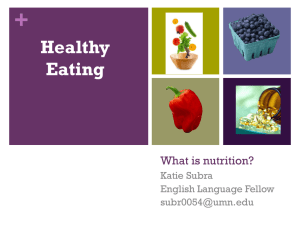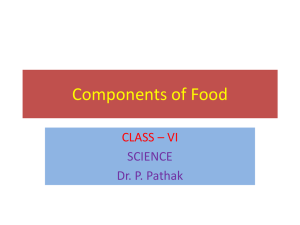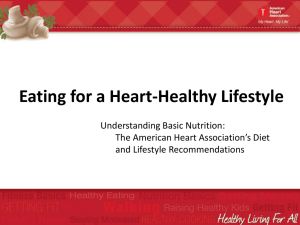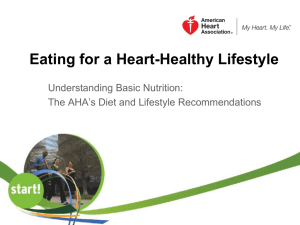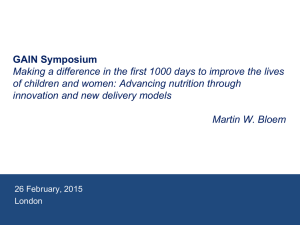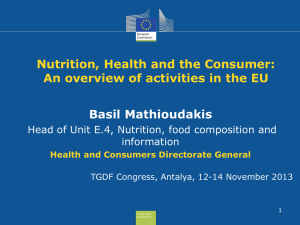Course Introduction - Department of Food Science
advertisement
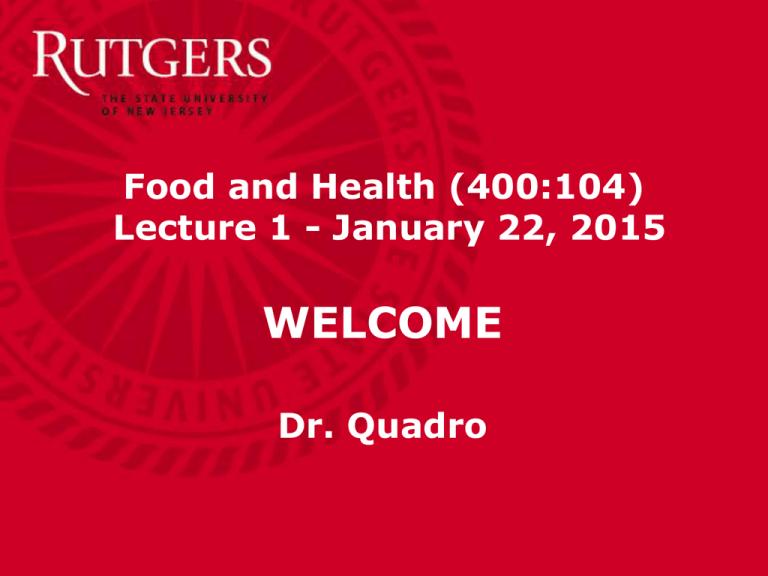
Food and Health (400:104) Lecture 1 - January 22, 2015 WELCOME Dr. Quadro January 22, 2015 Course Website http://foodsci.rutgers.edu/fs104/index.html • Lecture Notes – ALL slides on web prior to class • Syllabus/Schedule • General Policies • Other Information and Links Department of Food Science January 22, 2015 Course Website Let’s go online: http://foodsci.rutgers.edu/fs104/index.html Department of Food Science January 22, 2015 Syllabus & Schedule • 28 in-class lectures • 3 Professors: Dr. Loredana Quadro Dr. Chitra Ponnusamy Dr. Mary Wasserman (Diet Analysis Project) Guest Lecturers: Dr. Lesley Wassef Dr. Julie Hirsch Dr. Pappas Department of Food Science January 22, 2015 Communication • Dr. Quadro’s office hours: Thursdays 2:30 – 4:30pm Cook Campus, Department of Food Science, Room 419 • Email correspondence with professors: lquadro104@hotmail.com cponnusamy104@hotmail.com mwasserman104@hotmail.com – With EACH email, you need to provide: • First & Last Name • Phone number – Please do not expect IMMEDIATE reply Department of Food Science January 22, 2015 Communication Make sure to check your Rutgers email account all the time Department of Food Science January 22, 2015 Materials – Textbook (chose what you prefer!) Nutrition, Science and Applications Smolin & Grosvenor Wiley Ed. Personal Nutrition Boyle & Long Cengage Learning Ed. Nutrition for Life Thompson & Manore Pearson Ed. Nutrition, From Science to You Blake, Munoz and Valpe Pearson Ed. Nutrition, Concepts & Controversies Sizer & Whitney Thomson Wordsworth Ed. Nutrition Now Brown CengageLlearning Ed. Three copies of Nutrition, Science and Applications are on reserve at the Chang Library (Foran Hall, Cook Campus) Department of Food Science January 22, 2015 Materials - Textbook Diet Analysis Program “Supertracker” available free of charges through the USDA website www.supertracker.usda.gov/ You will need it for your Diet Analysis Project Department of Food Science January 22, 2015 Syllabus-Topics Food Biochemistry and Physiology • Digestion and Indigestion • Carbs: Sugars, Starches, Diets • Fats: the Good and Bad • Proteins: Enzymes, Hormones, Body Building • Vitamins: Water & Fat Soluble • Minerals and water Personal Nutrition • Energy & Calories • Nutrition and Lifecycle • Nutrition and fitness Department of Food Science Food and Health and Disease • Malnutrition • Over-nutrition and obesity • Diabetes • Food and Your Heart • Nutrition and Cancer • Introduction to Nutrigenomics • Food Allergies • Nutrient-drug interaction • One related movie Food Science/Technology • Microorganisms in food • Food Labels January 22, 2015 Learning Assessment 4 Exams Exam 1 Exam 2 Exam 3 Exam 4 February 12 March 12 April 9 May 4 Diet Analysis Project Department of Food Science January 22, 2015 In-Class Exams - Mandatory Exams: Loree 022 --- 12:30-1:55pm • Each worth 16.6% of your grade • Anyone caught cheating will be dealt with harshly (http://academicintegrity.rutgers.edu/integrity.shtml) • No Make-Up Exams (contact Dr. Quadro ASAP should any problem or conflict arise) Department of Food Science January 22, 2015 In-Class Exams - Mandatory Each exam will consist of 50 questions shared between multiple choices, matching and true and false. Each question will be worth 1 point, for a maximum of 50 points (in case all 50 questions will be correct). Department of Food Science January 22, 2015 EXAMS Department of Food Science January 22, 2015 Diet Analysis Assignment Mandatory Worth 33.6% of your grade (100 points) EARLY Submission (10 extra points) • WHEN: March 5 • WHERE: in-class after lecture • Extrapoints will be given only if attendance to lecture 9 and 10 is confirmed (attendance will be taken on those two days) FINAL Submission • WHEN: • WHERE: March 12 in-class after exam 2 For each day you will be late, 10 points will be taken away Department of Food Science January 22, 2015 Diet Analysis Assignment Mandatory All details/instructions will be provided during: Lecture #10 Monday, February 23 (Dr. Quadro/Dr. Wasserman) DO NOT MISS IT! Will use “Supertracker” Program (free of charges through the USDA website) Department of Food Science January 22, 2015 Diet Analysis Project Department of Food Science January 22, 2015 Extra points • Early submission of the DA project - 10 points will be added to the total points that you scored for your DA project IT IS YOUR CHOICE! Department of Food Science January 22, 2015 Grading Grades will not be curved! 1. Exam 1 2. Exam 2 3. Exam 3 4. Exam 4 5. Diet Analysis 16.6% of Final Grade 16.6% of Final Grade 16.6% of Final Grade 16.6% of Final Grade 33.6% of Final Grade 66.4%of final grade All 5 assessments are mandatory for you to pass the course Department of Food Science January 22, 2015 Grading Max number of points Exam 1 Exam 2 Exam 3 Exam 4 Diet Analysis 50 points 50 points 50 points 50 points 100 points TOTAL 300 points Department of Food Science January 22, 2015 Grading Example 1: Exam 1 Exam 2 Exam 3 Exam 4 Diet Analysis 35 points 48 points 47 points 45 points 85 points TOTAL 260 points/300 points% = 86.6% FINAL GRADE = B+ Department of Food Science January 22, 2015 Grading Example 2: Exam 1 Exam 2 Exam 3 Exam 4 Diet Analysis DA early submission 35 points 48 points 47 points 45 points 85 points 10 points TOTAL 270 points/300 points% = 90% FINAL GRADE = A Department of Food Science January 22, 2015 Courtesy • We start on time – please don’t be late • Turn off your cell phones BEFORE class – No telephone calls or text messaging or internet browsing (Facebook, newspapers, etc.) during lectures!!! Department of Food Science January 22, 2015 TODAY’s Lecture • • • • • • Define: Food, Nutrition, Health What is Nutrigenomics Molecular Nutrition Making the Right Food Choices Introduction to the Pyramid/Myplate Functional Foods Department of Food Science January 22, 2015 FOOD Any substance that is eaten or otherwise taken into the body to sustain physiological life by providing energy and “body building blocks” Department of Food Science January 22, 2015 NUTRITION The sum of biochemical and physiological processes concerned with the growth, maintenance, and repair of the living body as a whole, or of its constituent organs Graham Lusk, The Science of Nutrition, 1928 Department of Food Science January 22, 2015 HEALTH A continued state of soundness and vigor of body and mind It is reflected in low infant mortality, longevity, low morbidity to infectious and chronic disease (i.e. increased resistance) Department of Food Science January 22, 2015 Consumers Feel that Nutrition Plays Greatest Role in Health Department of Food Science January 22, 2015 Why do we eat? - Functions of Food • • • • • • • • • • • • Provide energy (maintain body functions, sustain physical activity, thermoregulation) Provide nutrients (sustain growth of the body, regulate body functions) Initiate and maintain interpersonal relationships Determine extent of interpersonal distance Express socio-religious beliefs Express social status prestige Recognize special achievement Cope with psychological stress Influence political economic status of a group Reward/punish influence others behaviors Detect, treat, prevent cultural behavior deviations Treat, prevent illness manifestations Department of Food Science January 22, 2015 What is the make-up of Food? Array of chemicals including – Water – – Nutrients Colors • Hundreds (ex. Carotenoids) Flavors • over 4000 identified Other known and unknown compounds – – Colors, flavors (and texture) provide sensory appeal to food Department of Food Science January 22, 2015 Type of nutrients and more.. Six classes of nutrients: Carbohydrates, Lipids, Proteins, Water, Vitamins and Minerals Essential nutrients (45): they cannot be made by the body or cannot be made in large enough quantities to meet needs Fortified Foods: foods to which nutrients have been added (milk with Vit A, grains with B vitamins and iron, orange juice with calcium, water with vitamins and minerals) Dietary Supplements Department of Food Science January 22, 2015 Type of nutrients and more.. Carbohydrates, Lipids, Proteins are energy-yielding nutrients Carbohydrates, Lipids, Proteins and water are MACRONUTRIENTS (constitute the major portion of most foods and are required in relatively large amounts in the body) Vitamins and Minerals are MICRONUTRIENTS (are needed in small amounts in the diet) Carbohydrates, Lipids, Proteins and Vitamins are ORGANIC MOLECULES/NUTRIENTS Minerals and Water are INORGANIC MOLECULES/NUTRIENTS Department of Food Science January 22, 2015 Composition of the human body Department of Food Science January 22, 2015 Macronutrients Micronutrients Department of Food Science January 22, 2015 Examples of Food Composition Tea No macronutrients No micronutrients Lots of antioxidants Chocolate Lots of carbohydrate Good amount of fat Some protein Lots of antioxidants Department of Food Science Salmon Little carbohydrate Good amount of fat Lots of protein Lots of antioxidants January 22, 2015 Functional Food General term for foods that provide an additional physiological benefit beyond that of meeting basic nutritional needs Substances that are not made by the body and are not necessary for life, but have health-promoting properties. They can be of plant origin (phytochemicals) or of animal origin. http://www.ific.org/nutrition/functional/index.cfm Department of Food Science January 22, 2015 Functional Food Inherently Functional = foods that have naturally present constituents that are protective of, or conducive to, good human health Fresh produce • Fresh fruit • Fresh vegetables Orange Juice Soy products Salmon Oats Ruminants meat Cranberry products Department of Food Science January 22, 2015 Functional Food Imposed Functional = foods to which bioactive components with potentially health benefits have been added Fortified & Enhanced foods Breads Energy bars Cereals Margarines Orange Juice Department of Food Science January 22, 2015 Early nutrition science efforts concentrated on eliminating deficiency diseases (abundant food supply and food fortification) Today, overnutrition, poor dietary habits, and environmental/lifestyle factors,contribute to development of degenerative and chronic diseases Diet is related to Top 5 of the leading causes of death: Department of Food Science Heart disease Cancer Stroke Diabetes Hypertension January 22, 2015 Molecular Nutrition Department of Food Science January 22, 2015 The Cell • • • • • Smallest unit of life. Can survive on its own or has potential to do so. Is highly organized for metabolism. Senses and responds to environment. Has potential to reproduce. Department of Food Science January 22, 2015 Structure of Cells Plasma membrane Cytoplasm Nucleus (compartment where DNA is stored) Department of Food Science January 22, 2015 What does a cell do? Department of Food Science January 22, 2015 Nutrigenomics Address the role of diet on the activity of individual’s genes and its effects on health Department of Food Science Copyright by J. Hirsch et al. January 22, 2015 Nutrigenomics Diet Health or Disease Department of Food Science Genotype Phenotype January 22, 2015 There are no bad foods, just bad diets! Department of Food Science January 22, 2015 Understanding Our Food Choices Food choices are influenced by: -What is available to us -Where we live -What is within our budget and compatible with our lifestyle -What we like -What is culturally acceptable -What our emotional and psychological needs are -What we think we should eat (health concerns) Department of Food Science January 22, 2015 Making the Right Food Choices Hunger vs. Appetite Right vs. Wrong Good vs. Bad Department of Food Science Why do you eat? What’s in your fridge? Where do you go out to eat? What do you think about when you buy/eat food? January 22, 2015 Department of Food Science January 22, 2015 1992 Food Guide Pyramid Department of Food Science January 22, 2015 2005 MyPyramid 12 pyramids based on calories and physical activity Department of Food Science January 22, 2015 2010 MyPlate http://www.choosemyplate.gov/ Department of Food Science http://www.choosemyplate.gov/downloads/GettingStartedWithMyPlate.pdf
